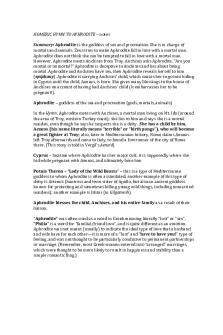3/8 Class Notes - Athena and Aphrodite PDF

| Title | 3/8 Class Notes - Athena and Aphrodite |
|---|---|
| Course | Classical Mythology |
| Institution | University of Delaware |
| Pages | 2 |
| File Size | 38.9 KB |
| File Type | |
| Total Downloads | 88 |
| Total Views | 137 |
Summary
Prof Sukava...
Description
Class 9 Notes: The Greek Pantheon, cont; Athena and Aphrodite Athena (Roman: Minerva) ● Depicted with war helmet ● Shield (aegis of Zeus) with Gorgons ● Long peplos (dress) ● In stories: a perennial virgin (like Artemis) ● Domains: ○ Textile production ○ Military strategy ○ Wisdom in general ○ Patron of heroes (often assists them in stories) Athena, Daughter of Zeus and Metis (‘Cunning’) ● Zeus heard prophecy from Gaia that he and Metis would produce a son that would overthrow him ● Zeus swallowed Metis to prevent this ● After realizing his hastiness, Zeus was assisted by Hephaestus to “deliver” the child Athena and Arachne ● Rare story of a vengeful Athena ● Arachne praised as magnificent weaver, but did not acknowledge Athena’s assistance ● Athena visits Arachne to warn her about insolence ● Arachne ignores advice ● They begin a competition ● Athena weaves a tapestry depicting humans being punished by the gods ● Arachne weaves a tapestry depicting instances of gods behaving badly ● Seeing Arachne’s tapestry, Athena beats the maiden ● The maiden hangs herself ● Athena transforms Arachne into a spider Athena and Arachne: What’s Going On? ● A morality tale, of sorts ● An instance of gnothi seauton (“know thyself”) ● Arachne has committed hubris by not acknowledging the benefaction of the goddess ● Arachne is punished Athena in Athens: The Contest ● Early in Athens’ legendary history, the city named “Cecropia” after first king ● Competition began for “patron” of the city, waged between Poseidon and Athena ● Poseidon promised horses (or salt water); Athena promised the olive tree ● Alternatively, outcome decided by a footrace between the gods to the top of the Acropolis ○ Athena wins
Use of Myth as Propaganda ● Athena Parthenos (“Athena the Maiden”) situated in Parthenon ● Nike in her hand ● Story of Pandora on base ● Amazons (vs Athens) and Gigantomachy on shield (along with gorgon head) ● Battle of Lapiths (neighboring community) and centaurs on sandals Use of Myth as Propaganda: Panathenaia ● “Panathenaia” introduced as public festival in honor of Athena ● Among the events were the ceremonial “dressing” of Athena with a new gown and sporting events ● Became a “Panhellenic” (“all of Greece”) event - but focused on Athenian excellence ● A virgin goddess who is “liminal” - contains both male and female attributes (as expected by ancient Greeks) ● Her roles and responsibilities are extensions of this liminal role and her parentage: Zeus and Metis (Cunning) ● Classical literature is saturated with references to Athena bc of the prominence of Athenian literature in surviving material Aphrodite (Venus) ● Born from the testes of Uranus ● Early depictions of appearance ○ Dressed as matron (married woman) at first ○ Fabric becomes thinner and thinner ○ More provocative later Aphrodite: Myths ● Two general elements: ○ Erotic love an imperative of living things ○ Avoiding it leads to self destruction ○ (Subtext: partaking in erotic love is a way to show reverence towards Aphrodite) Eros ● ● ●
Son of Aphrodite Primordial being (with Gaia) Later (as Roman ‘Cupid’ or ‘Amor’) ○ Boy god ○ With bow and arrow ○ ‘Shoots’ mortals to make them fall in love...
Similar Free PDFs

14 Hephaestus and Athena
- 3 Pages

Athena and Poseidon GRS
- 2 Pages

Athena and Apollo
- 3 Pages

Aphrodite and Artemis
- 5 Pages

EOCR- Exercise 38 - for class
- 6 Pages

Homeric HYMN TO Aphrodite notes
- 2 Pages

Constitution - Lecture notes 38
- 37 Pages

Notes and Summary of Ch.38
- 8 Pages

Homeric Hymn to Aphrodite
- 2 Pages

Athena students guide v2
- 18 Pages

Chapter 38 Rest and Sleep
- 2 Pages

27 (38) - Lecture notes 5
- 13 Pages

Class Notes
- 4 Pages
Popular Institutions
- Tinajero National High School - Annex
- Politeknik Caltex Riau
- Yokohama City University
- SGT University
- University of Al-Qadisiyah
- Divine Word College of Vigan
- Techniek College Rotterdam
- Universidade de Santiago
- Universiti Teknologi MARA Cawangan Johor Kampus Pasir Gudang
- Poltekkes Kemenkes Yogyakarta
- Baguio City National High School
- Colegio san marcos
- preparatoria uno
- Centro de Bachillerato Tecnológico Industrial y de Servicios No. 107
- Dalian Maritime University
- Quang Trung Secondary School
- Colegio Tecnológico en Informática
- Corporación Regional de Educación Superior
- Grupo CEDVA
- Dar Al Uloom University
- Centro de Estudios Preuniversitarios de la Universidad Nacional de Ingeniería
- 上智大学
- Aakash International School, Nuna Majara
- San Felipe Neri Catholic School
- Kang Chiao International School - New Taipei City
- Misamis Occidental National High School
- Institución Educativa Escuela Normal Juan Ladrilleros
- Kolehiyo ng Pantukan
- Batanes State College
- Instituto Continental
- Sekolah Menengah Kejuruan Kesehatan Kaltara (Tarakan)
- Colegio de La Inmaculada Concepcion - Cebu


